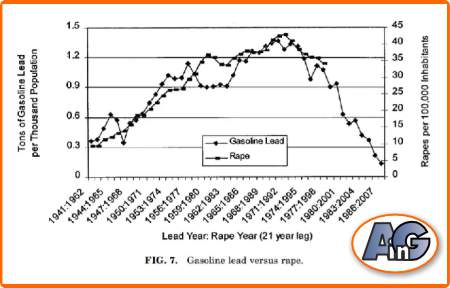The finest quality crystal from Waterford, Bacarrat, Lalique, Orrefors, and other prestigious companies has always been made with 24% or more lead oxide (PbO). Research in the 1990s found that lead can leach from crystal decanters and contaminate your whiskey, sherry, or wine. So, is lead crystal dangerous? And if so, what should you do about it?
Update for 2024: now that the danger of lead poisoning is well understood, all modern crystal and glassware is manufactured without lead. Even the Swarovski Company stopped using lead in their decorative figurines (in 2012). So lead is only a potential threat to health if you use “legacy”, vintage or antique crystal – that is crystal manufactured before the year 2000.
It is not safe to store liquor in a lead crystal decanter but, with some reservations, it’s OK to drink the occasional glass of wine from a crystal wine glass. To reduce the risk of lead contamination, rinse your crystal with a solution of vinegar before using it. Women who are pregnant or planning to become pregnant should never use lead crystal.
Lead Poisoning Update
This post discusses crystal and glassware but a much larger danger of lead poisoning arises out of the presence of lead in drinking water (from lead pipes), in gasoline, paint, children’s toys, and other sources.
Follow this link for important warnings about the continuing danger of lead in the environment.
US citizens are familiar with the dangers of lead because of recent scandalous events in cities like Flint Michigan. UK campaigners identify serious health consequences as a result of exposure to lead: including reproductive, neurological, psychological, cardiovascular, renal, and other issues.
New – update on UK lead water pipes
What is lead crystal?
The term Crystal is derived from the Italian Cristallo which described the rock crystal (quartz) that Murano glassmakers in Venice imitated in the 15th century. In the 17th century, it was found that lead oxide (PbO) increases the refractive index (RI) of crystal giving it a greater sparkle than regular soda-lime glass.
The RI of full lead crystal is between 1.7 and 1.8 compared to about 1.46 for regular glass (For comparison the highest RI in nature is that of diamonds at 2.4).
Lead crystal is also softer than soda-lime glass making it easier to cut and polish into the sparkling facets that characterize the best brands. Finally, lead crystal rings with a sonorous bell-like tone when struck.
As an Amazon Associate, I earn from qualifying purchases
Definitions of lead crystal
In the USA, lead crystal generally refers to glass with 24% or more PbO (lead oxide). The European Union (EU), has been more precise, defining various categories of crystal in a comprehensive 1969 directive (69/493/EEC).
This directive distinguished Full Lead Crystal, Lead Crystal, and Crystal Glass according to the specifications shown below:
EU Definitions of Crystal (1969)
| Type of Crystal | Lead % PbO | Density grams/cc | Refractive Index (RI) |
| Full Lead Crystal | ≥ 30 | ≥ 3.00 | ≥ 1.54 typically 1.7 |
| Lead Crystal | ≥ 24 | ≥ 2.90 | |
| Crystal Glass | ≥ 10 * | ≥ 2.45 | ≥ 1.52 |
| Glass ** | ≥ 0.5 | about 2.5 | 1.46 |
Note that this directive did not prohibit the production of lead crystal but it did regulate the labeling of crystal products for consumer information.
Most crystal manufactured today is marketed as “lead-free” and is “Crystal Glass” according to the 1969 EU directive. The enhanced refractive index (sparkle) comes using barium (BaO), zinc (ZnO), and potassium (K2O) instead of lead (PbO).
Why worry about lead?

We later describe strategies for safeguarding your family against the danger of lead poisoning from lead crystal (jump to this section for a summary) but first – why worry about lead?
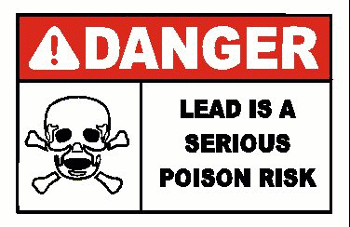
Do not underestimate the dangers of lead!
Lead poisoning has had a massive negative influence on world health in the 20th century. Follow this link for remarkable evidence linking blood lead in pre-school children to social ills including, violent crime, rape, and murder.
It is not an exaggeration to say that lead poisoning has had a massive role in world health and consequent social disease in the 20th century. The Institute for Health Metrics and Evaluation (IHME) estimated that in 2019, lead exposure accounted for 900 000 deaths and 21.7 million years of healthy life lost worldwide due to long-term effects on health.
Since the banning of lead in gasoline, the current causes of lead poisoning are lead-based paints, water pipes, imported canned goods, soil, toys, household dust, pottery, lead bullets, paints and art supplies, and batteries. Recent research shows that lead in soils (from years of leaded gasoline contamination) continues to be a source of dangerous poisoning in urban areas.
The IHME does not identify lead crystal as a source of concern so, is lead crystal dangerous and if so, what is the evidence?
Influence of California Proposition 65
Proposition 65, officially known as the Safe Drinking Water and Toxic Enforcement Act of 1986, was used to mandate warning labels on all lead crystal. This negative publicity for their trademark products led all crystal companies to eliminate lead from their crystal in the early 1990s.
Manufacturers’ response to Prop 65
Although there has, to this writer’s knowledge, never been a successful class action suit for damages caused by lead in crystal, negative publicity from California’s Prop 65 caused most crystal manufacturers to stop using lead and, in some cases, go out of business.
Since then, there has been a conspiracy of silence from current crystal manufacturers. Not a single one even mentions the word lead on their websites. They have airbrushed the chemical from history as surely as the Politbureau used to airbrush deposed Communist leaders from the Soviet podium in Red Square.
Evidence for lead leaching from lead crystal
Groundbreaking research on the release of lead from lead crystal decanters was carried out by S.J.BarbeeL.A.Constantine in 1994. They found that dangerous amounts of lead can leach from lead crystal decanters into wines, spirits, or acidic liquids.
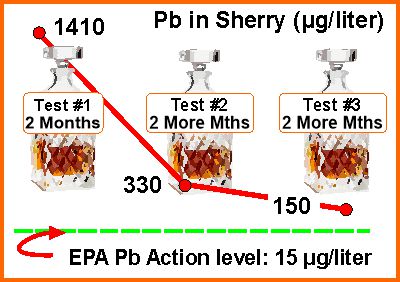
The findings of this research are very educational: follow this link for full scientific details:
So, lead is dangerous – what should you do?
Tip #1 Buy lead-free crystal
Out of an excess of caution, and given the very serious consequences of lead poisoning it is a very good idea for young families, setting up house for the first time, to purchase only lead-free crystal.
Why take the risk? Remember that, according to the CDC, lead in the bones or blood of a pregnant woman can expose her developing baby to serious health risks.
Numerous very stylish lead-free crystal decanters are available on Amazon. As crystal experts for more than 35 years, two of our favorites for wine and liquor are:
Excellent quality double old-fashioned glasses are now available without lead – like these (below) from Amazon:-
Tip #2: Find out if your prized crystal contains lead
You have inherited crystal wine glasses or a decanter set – or you have purchased crystal from an estate sale – jump to this section for advice on how to tell if your crystal contains lead.
Tip #3: If your crystal contains lead, take the following precautions:
If you are a woman who is pregnant or planning to have kids it would be best to keep that crystal decanter and those beautiful Waterford crystal glasses on display in the china cabinet.
If, on the other hand, you are a mature couple then you can enjoy your crystal with the following caveats:
Tip #4: Using lead crystal wine glasses
It is extremely unlikely that drinking wine from a lead crystal wine glass will result in lead poisoning. If you pour yourself a glass of wine and drink it right away there is simply not enough time for significant lead leaching. So feel free to use your cherished Lismore wine glasses for special occasions. However, for extra precaution (and for extra sparkle), rinse with a vinegar solution before use.
Tip #5: Using lead crystal decanters
Research shows that a significant amount of lead can leach from lead crystal decanters and other storage vessels. This is especially problematic with acidic and alcoholic liquids. So the sensible advice is – do not store your wines or spirits in a lead crystal decanter.
If you insist on using your heirloom crystal note that an old (much used) decanter is much less dangerous than a brand-new one. Also, lead leaching can be reduced by rinsing or soaking with vinegar before use.
So, decanting alcohol into a decanter a short time before serving, and then using it promptly, is a safe way to avoid dangerous lead leaching (but still not recommended for pregnant women!)
Tip #6: Don’t use lead crystal baby bottles
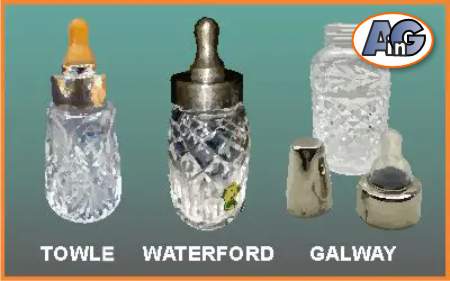
1991 San Francisco lawsuit ordering Waterford to withdraw their lead crystal baby bottles from stores was reported in the LA Times but the result was not published (it was presumably settled out of court). Waterford no longer produces baby bottles of any type (leaded or lead-free!)
Given the crucial impact of lead poisoning in preschool children, it is vital to keep these bottles well away from your baby. The examples pictured above are all currently available for sale on eBay and should obviously be used for decoration and display only.
Tip #7: Don’t use lead crystal cruet sets
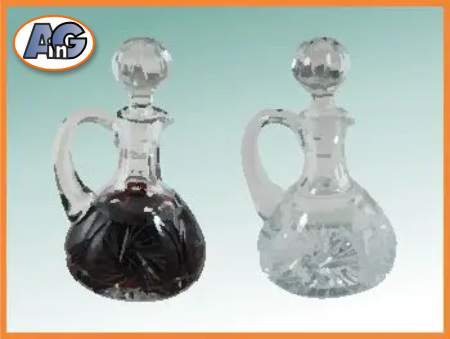
Here is another dangerous category of glassware that is still available second-hand on eBay and other sites in 2023. Vinegar is especially effective at extracting lead from lead crystal and it is also likely to be left in the cruet for extended periods. So – better to leave these sets for display in the china cabinet.
In conclusion: be very aware of the dangers of lead: use lead crystal with care following the recommendations in this post and avoid lead crystal is if you are pregnant or planning to be pregnant.
How to tell if your crystal contains lead?
You have inherited a collection of crystal stemware and decanters – or purchased crystal at an estate sale or from an antique shop – how can you find out if your crystal contains lead?
Look for an etched trademark on the base of the glass (or an original label) to identify the maker. Crystal manufactured before the 1990s by prestigious companies like Waterford, Baccarat, Lalique, Stueben, Kosta Boda, Orrefors, and many others almost certainly contains 24 % PbO or more.
Try the tap test: carefully tap the rim of a glass with a metal object. Lead crystal glasses will sound like a bell with a protracted ring, whereas soda-lime glass makes a dull, briefer sound. (update: many fine, lead-free crystal glasses, like those made by Reidel, also ring like a bell).
Examine the rim: Lead and other crystal glasses have “shear” rims whereas inexpensive restaurant-style glasses have “rolled” rims:
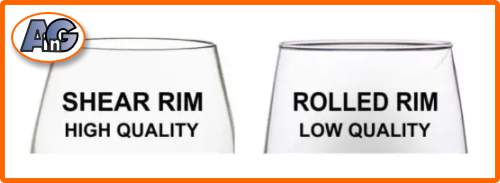
Note: shear rims do not prove that your crystal has lead – but rolled rims prove that they do not have lead.
Compare the weight: lead crystal is noticeably heavier than glass – (see this table for details).
Compare the “sparkle”: lead crystal has a higher refractive index and will generate rainbow-like prismatic effects when the decorative cuts are seen in sunlight.
Use a test kit: to analyze for lead – but see the limitations below
Test kits available on Amazon are a quick way to test for lead in paint and surfaces in the home. To analyze crystal you need to sacrifice one of the glasses and grind up a small chip to test. Or, you could leave vinegar in a glass or decanter for a month or so, evaporate the liquid, and test the residue.
Interested in the safety of your glass tabletops? – learn about tempered glass in this post.
The science of lead release into liquids
The release of lead from lead crystal decanters was studied by S.J.BarbeeL.A.Constantine in 1994.

The amount of lead released, from a lead crystal decanter, into sherry was measured in three tests. After 2 months in the new decanter, sherry contained 1410 μg/Liter of lead. A new bottle of sherry poured into the same decanter and left for 2 months leached out much less lead (330 μg/L), and the same decanter when tested for a further 2 months yielded only 150 μg/L.
Leaching of lead from a crystal decanter decreases with continued use
The results show that the leaching of Pb from crystal is self-limiting – the more lead is leached out, the less remains to be leached. (in scientific lingo: lead leaching decreases exponentially as a function of increasing distance from the crystal—liquid interface).
In what many critics consider an over-reach, the State mandated labeling of all glassware composed of lead crystal. The poster below contains +/- 120 companies who were doing business in California in the 1990s selling lead crystal.
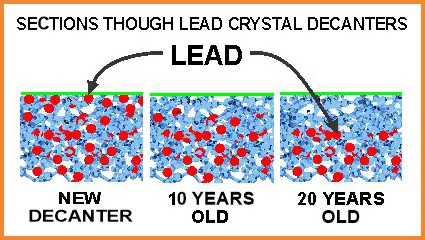
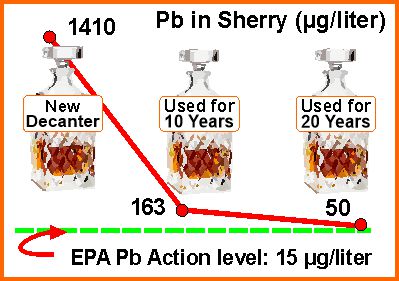
Effects of lead exposure in pre-school children
Symptoms of lead poisoning, include weakness, fatigue, nausea, cramps, vomiting, and headaches. Long-term exposure can cause significant brain and nervous system dysfunction in adults but very much more serious consequences occur in children.
In landmark statistical analyses, Rick Nevin has shown how blood levels in pre-school children correlate with lower IQ scores, which in turn correlate with increases in social problems like teen pregnancy, rape, robbery, and even murder.

High lead levels are followed 21 years later by high US murder levels in data from Nevin (2000). The two peaks in lead levels correspond to the use of lead in white paint and lead in gasoline.
The correlations between blood levels in preschool children and social problems are so astonishingly clear that lead poisoning qualifies as one of the most consequential influences in crime and social well-being in the entire 20th century.
Furthermore, the effects are concentrated on lower-income and disadvantaged segments of the population who live in older homes with flaking lead-based paints or in distressed cities like Flint, MI with decaying infrastructure and negligent city officials.
Relation between blood lead in children and US crime

Lead in gasoline and US cases of rape 1940-2007
Important update on the toxic legacy of lead
Despite the elimination of leaded gasoline across the globe, leaded particles from gasoline emissions have settled in the soil and continue to haunt cities around the world. Researchers in U.S. cities have found that residents of highly trafficked urban centers are exposed to lead particles in the soil that are resuspended into the atmosphere during the summer and fall, particularly during hot, dry weather.
Concerned parents should monitor the blood-lead levels of their children.
California Proposition 65
Proposition 65, officially known as the Safe Drinking Water and Toxic Enforcement Act of 1986, was enacted as a ballot initiative in November 1986. Prop 65 protects California’s drinking water sources from contamination with chemicals known to cause cancer, birth defects, or other reproductive harm, and requires businesses to inform Californians about exposures to such chemicals.
Warning labels required on lead crystal
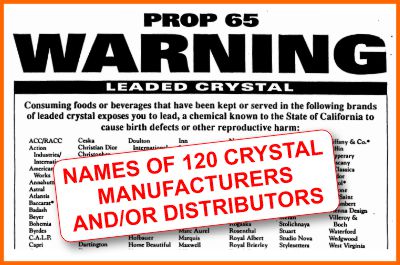
Crystal manufacturers and distributors identified in Prop 65 lead warning poster:
As a consequence of Prop. 65, the State of California required all lead crystal distributed in California to carry the following warning:
Consuming foods or beverages that have been kept or served in the following brands of leaded crystal exposes you to lead, a chemical known to the State of California to cause birth defects or other reproductive harm. (this is the list of crystal distributors identified in the poster – surviving companies are hyperlinked for reference):
ACC/RACC, American Glassworks, Annahütte, Astral, Atlantic (now Bonadea), Baccarat, Badash, Beyer, Bohemia, Capri, Cartier, Castle, Ceska (now Godinger), Christopher Stuart (now from Poshmark), Christian Dior, Cristal de Sevres, Cristallerie Zweisel, Crystal Clear, Crystal Legends, Colle, Colony, Dansk, Dartington, Daum, DaVinci, Design Guild, Doulton International (now Royal Doulton), Dublin (now Dublin Crystal), Edinburgh, Emerald Isle, Euport, Faberge, Fostoria, Galway, Godinger, Gorham, Hermes, Hofbauer, Hoya, Illusions, Imperlite, Imperlux, Inn, Trena, Jonal, Kagami, Kosta Boda, Lalique, Legacy, Lenox, Magic, Marc Aurel, Marquis (Waterford), Maxwell, Mikasa, Miller Rogaska (at Crystal Classics), Mozart, Nachtmann, Noritake, Ofnah, Oneida, Orrefors, Oscar de la Renta, Pasabahce, Primavera di Cristallo (part of RCR), Ralph Lauren (at Crystal Classics) , Riedel, Rosenthal, Royal Albert, Royal Brierley (part of Dartington), Royal Crystal Rock (RCR), Royal Doulton, Royal Monarch, Saint Louis, Sasaki, Savoir Vivre, Schonwald, Schott (sold by Williams Sonoma), Sculptured, Slovakia, Spiegelau, St Brendon, St George, Stefan, Stolichnaya, Stuart, Studio Nova, Svend Jensen, Thieresienthal, Thomas, Thomas Webb, Tiffany & Co, Tiffin, Tipperary, Tudor, Tyrol, Tyrone, Val Saint Lambert, Villeroy & Boch, Waterford, Wedgewood, West Virginia, WMF, Zwiesel Glass (now Schott Zwiesel).
Has Prop 65 been an opportunity for “bounty hunter” attorneys?
The issue of lead in crystal has never, to this writer’s knowledge, been the subject of any class-action lawsuits of the type such as those brought against Monsanto (for Roundup) or Johnson & Johnson (for talcum powder).
Presumably, this is because there has been no convincing evidence of lead poisoning as a result of drinking liquids stored in lead crystal. Minor legal actions have concentrated on mandating warning labels such as this case involving Lalique and prohibiting the sale of lead crystal.
1991 San Francisco lawsuit ordering Waterford to withdraw their lead crystal baby bottles from stores was reported in the LA Times but the result was not published.
Prop. 65 is intended to safeguard the public against dangerous chemicals, but many critics believe it has resulted in abusive practices brought forth by some private enforcers who simply want to leverage small businesses into costly settlements without any significant basis for the lawsuit.
This certainly seems to have been the case with the lead crystal warning issue as evidenced by the latest lawsuit brought against the Fiskars Group (owners of TJ Max, Marshalls, and Homegoods.
A recent report highlights the tragic effects of lead poisoning
Statistics fail to bring home the true consequences of lead poisoning. Read this recent Washington Post article for a true and tragic story.
Is leaded stained glass dangerous?
Artistry in Glass owner and Ph.D. scientist, John Wakefield tells you all you need to know about lead in stained glass in this informative post.
Glass safety – learn from the experts!
- Choosing between tempered & laminated glass
- Broken glass injuries and how to avoid them
- Is wired glass safe?
- What is safety glass?
- What is tempered glass?
- What is Gorilla Glass?
- Plexiglass vs glass
- Should glass shelves be tempered?
- Should glass tabletops be tempered?
- Is lead crystal dangerous?
- Is leaded (stained) glass dangerous?
- How to repair cracked stained glass
Unique Mirror Resources from Artistry in Glass
Mirror Design & layout
- How are mirrors made?
- What is a beveled mirror?
- What is a two-way mirror?
- Best mirrors for bedrooms
- How to size and position your wall mirror
- How to order custom etched mirrors
- Best places to hang dining room mirrors
- How much do wall mirrors cost?
- Shop the MIRROR Family Package
Mirror Installation & Removal
- How to hang a wall mirror
- How to frame a builder’s grade bathroom mirror
- How to hang a frameless mirror with glue
- Best clips for hanging mirrors
- How to attach a mirror to a closet door
- How to remove a mirror glued to the wall
Mirror Repair & Restoration
- Should I resilver my antique mirror?
- Can I repair scratched mirror silvering?
- What is the best spray paint for mirror silvering?
- How to fix a cracked mirror
- How to repair a broken mirror frame
Artistry in Glass was your source for antique repair in Tucson
Check out this amazing selection of informative articles:-
- Where can I get antiques repaired?
- Are broken antiques worth fixing?
- How to fix a broken picture frame
- How to repair a broken china plate
- How to repair a broken china teapot
- How to fix a broken marble slab
- How to repair a broken china coffee mug
- How to repair a 2000-year-old sculpture
- All about repairing stained-glass lampshades
- How to care for your stained glass skylight
- How to repair Dalle de Verre
- Is stained glass worth repairing?
- To repair or toss out?
- Tucson crystal & china repair a division of Artistry in Glass
- What to do with broken antiques
- Is lead crystal dangerous?
- Repairing an antique Mexican statue
- Repairing religious statues
- The history of Swarovski crystal figurines
- How to find the value of a Swarovski Crystal figurine
- Have Swarovski crystal figurines lost value since 2009?
- How to collect Swarovski annual ornaments
- How to display Swarovski crystal figurines
- How to authenticate a Swarovski crystal figurine
- How to display Swarovski annual ornaments
- How to clean Swarovski crystal figurines
- How to repair a Swarovski crystal mouse
- How to repair a Swarovski annual ornament
- How to repair a Swarovski crystal train set
- Fixing broken wine glass stems
- How to clean cloudy glasses
- Why do wine glasses have stems?
- Swarovski Crystal Figurines
- How to repair a chip in a wine glass
- How to fix a scratched glass tabletop
- How to replace a broken patio tabletop








